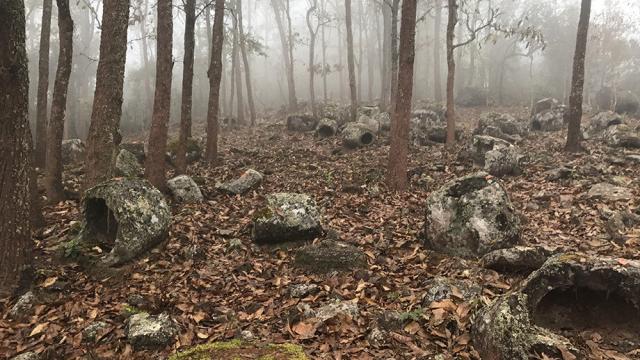An ancient burial practice involving the use of massive stone jars seems to have been more widespread in Southeast Asia than once assumed, owing to a surprising trove of new discoveries in Laos.
A team of archaeologists co-led by Dougald O’Reilly from the Australian National University, with help from Lao government officials, have discovered 15 new megalithic sites in Laos containing 137 previously unidentified stone jars that are thought to have been related, in some way, to disposal of the dead.
The sites, which date back 1000 years, are located in a remote mountainous forest, expanding the geographical area in which these monuments are found in Laos.
“These new sites have really only been visited by the occasional tiger hunter,” said ANU PhD student Nicholas Skopal, a co-leader of the team, in an ANU statement. “Now we’ve rediscovered them, we’re hoping to build a clear picture about this culture and how it disposed of its dead.”
These so-called ‘Jars of the Dead’ have been known since the 19th century, but French archaeologist Madeleine Colani was the first to conduct a scientific investigation of the monuments, which she did in the 1930s.
Thousands of the megaliths have been found in the Plain of Jars, an area concentrated along the central plain of Xiangkhoang Plateau in northern Laos. The jars measure a couple of metres across and date back to Laos’ Iron Age (500 BCE to 500 CE).
Colani, and the archaeologists who followed in her footsteps believe they were used during ancient burial practices, either to temporarily hold a deceased individual or to serve as a secondary gravesite. Or possibly both.
These jars, and others like them in India and Indonesia, are suggestive of a complex set of burial practices involving various stages of decomposition, which ancient peoples may have associated with various spiritual or metaphysical phases of death.
But archaeologists have long puzzled over the exact purpose of the jars. To compound the problem, researchers don’t even know which culture built these megaliths.
“It’s apparent the jars, some weighing several tonnes, were carved in quarries, and somehow transported, often several kilometres to their present locations,” said O’Reilly in the ANU statement. “But why these sites were chosen as the final resting place for the jars is still a mystery. On top of that we’ve got no evidence of occupation in this region.”
As noted, the distribution of the jars appears to be more widespread than previously assumed, which suggests whatever burial practice they were related to was also more common.
Also, some intricately carved discs were found positioned around the jars, possibly serving as burial markers, according to the researchers. The discs, which were placed face down for some unknown reason, were decorated with pommels, concentric circles, animal imagery and human figures.
According to O’Reilly, decorative carvings around these giant jars are quite rare. The researchers aren’t sure why some monuments were decorated and others were not, and why some had geometric designs as opposed to other imagery.
Intriguingly, the archaeologists also found miniature jars made of clay, which greatly resembled the larger jars. O’Reilly said he’d “love to know why these people represented the same jars in which they placed their dead, in miniature to be buried with their dead”.
Other artefacts found near the jars included decorative ceramics, glass beads, iron tools, earrings, and spindle whorls for making cloth.
Looking ahead, the researchers are hoping to extract DNA from bodies found buried nearby according to a paper published last year, and to conduct a comparative analysis of similar megalithic jars from the Assam region of India and Sulawesi in Indonesia.
